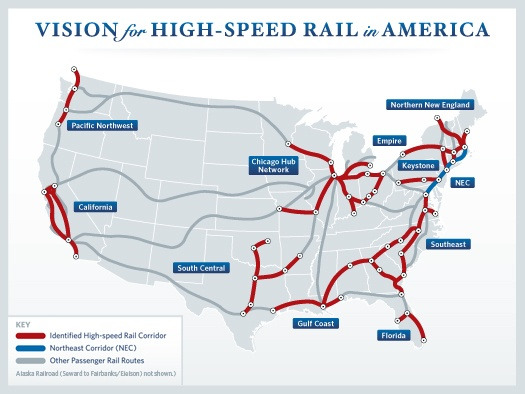All Aboard: High Speed Rail Funding Announced
By Amy Perry in News on Jan 28, 2010 8:30PM

Image via the White House
Last year it was announced the city might be a high speed rail hub. Today, it was confirmed as Illinois learned how much funding will be received to build a high speed rail link between Chicago and St. Louis. The Obama Administration announced Illinois will be awarded $1.23 billion of the $8 billion in economic stimulus grants, under the American Recovery and Reinvestment Act, for the designated 31 states to develop 13 high-speed rail corridors linking major cities and the rural areas between them. Illinois officials, along with Gov. Pat Quinn, hoped the city would receive at least $2 billion. The grant will serve as a down payment towards construction of a Midwest high speed rail network, which will total $2.6 billion and connect every major city within 400 miles of Chicago.
The Midwest system is referred to as ''high-speed rail,'' although it won't reach the speeds seen in Europe and Asia. California's trains, slated to receive $2.34 billion for a 220-mph passenger service between Los Angeles and San Francisco, will be the fastest, exceeding the 200 mph achieved by some trains overseas, according to The New York Times. Other Midwest states are slated to receive grants including, $823 million to Wisconsin for a Chicago-Milwaukee-Madison high-speed link and $244 million to Michigan for the Chicago-Detroit corridor.
The Chicago Tribune reports how the Illinois grant will be broken down:
- $1.1 billion to construct tracks, install signals, build stations and buy some locomotives and passenger coaches for 110 mph service between Alton, Ill., near St. Louis, to Dwight, Ill.
- $133 million to build the Englewood flyover bridge near 63rd Street in Chicago. The flyover is intended to reduce delays by separating Metra Rock Island commuter trains from Amtrak and freight trains on one of the most congested rail junctions in the U.S.
- $1.25 million to conduct an environmental impact study on a proposal to build a second set of tracks between Chicago and St. Louis to accommodate 110 mph trains.
There are some who oppose the high speed train but others including Brian Imus, Director of the Illinois Public Interest Research Group, support the investment saying it “will put people back to work in Illinois, clean our air, cut our energy consumption, and assist in the resurgence of American manufacturing. For millions of inter-city trips, high speed rail will be a faster, cleaner, more efficient way to travel across the state than driving or flying.” Imus feels that in order to maximize this initial investment, Illinois lawmakers and Congress should focus on securing more long-term funding for both high speed rail and the local public transit systems that will eventually feed into it.